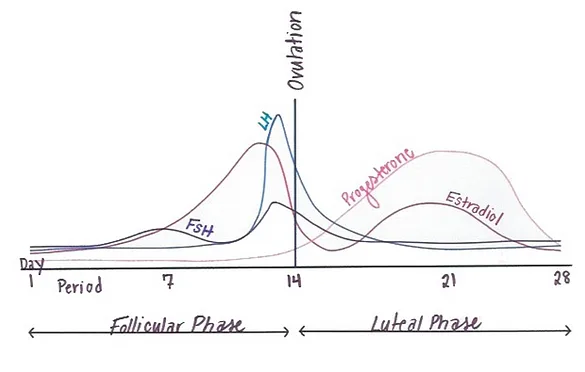What is a Normal Cycle?
I often find myself talking to my patients about abnormal cycles – whether that be the length of their period/cycle, the amount of flow, clotting, pain, etc. I thought that I would go back to some basics this week to write about what a normal cycle should look like.
The Basics:
A typical cycle comes every 25-30 days, menses is 5-7 days. As far as flow is concerned, you should not have to change more than a pad or super tampon every hour for three or more consecutive hours in one day. Initially, your blood should appear similar to a bright red in color and can then fade to a brownish color as your period ends. PMS and cramping should be minimal and you should not experience pain during your period. Even a “normal” cycle varies from person to person. The moral of the story is that a cycle should not be too long or short and should not affect your daily life. If your cycle is impacting your lifestyle then chances are you have an abnormal cycle.
Hormones:
Ok let’s talk hormones, female hormones. What are they and how do they change over the course of the month? Here’s the breakdown.
The main hormone players in females are Estrogen, Progesterone, Luteinizing Hormone (LH), Follicle Stimulating Hormone (FSH), and Testosterone. Depending where you are in your cycle, the levels are different. LH and FSH are produced in your brain and travel down to your ovaries to trigger ovulation. Estrogen Progesterone are produced in your ovaries where they function to prepare your uterus for pregnancy by producing and maintaining your uterine lining, making it a cozy environment for a fertilized egg. How these hormones work together is easier to show visually.

The Cycle:
Your cycle is broken down into 2 main phases – the Follicular Phase, which is from day 1 to 14, and the Luteal Phase, which is day 14-28. As you can see, your Period starts on day 1 of your cycle which is in the Follicular Phase. At the start of the follicular phase, your estrogen, progesterone, FSH, and LH levels are low. As we move into the next few days of the cycle, your Period will end, typically around day 5-6. Leading up to day 14, which is when Ovulation occurs, your estrogen levels start to increase. This is what is getting your uterus ready for ovulation. Right before Day 14, LH and FSH spike; triggering Ovulation! Ovulation is the time in a woman’s cycle that an egg is released. The Luteal Phase begins after Ovulation and is when estrogen levels rise. This function of this rise in estrogen is to prepare the uterus for pregnancy. Your progesterone levels also begin to rise dramatically and peak during day 21 of your cycle. This prepares the uterus, by building the uterine lining for implantation of the egg if it is fertilized by sperm during the magic window in your cycle. If the egg implants into the uterus, this is a pregnancy and estrogen and progesterone levels will remain high to maintain the pregnancy. If the egg is not fertilized, your levels of estrogen and progesterone decrease and the uterine lining is shed, AKA your period and the cycle begins anew!
Disclaimer: All material on this website is for informational and educational purposes only and is not a substitute for the advice provided by your healthcare professional or physician.